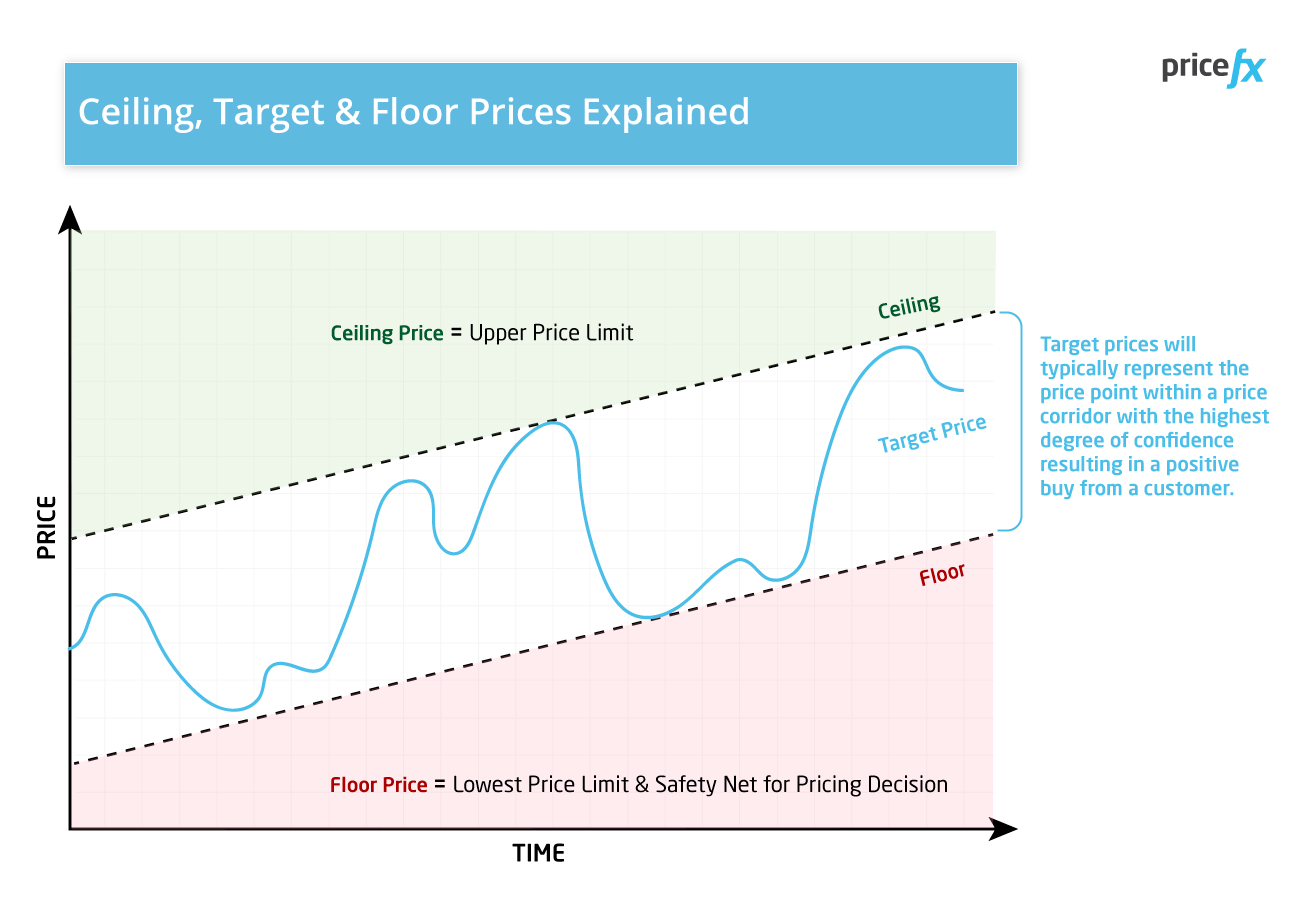Price Corridors: What Are They & How Are They Built?
September 13th, 2023 | 9 min. read
By Jose Paez
More than ever, it is now increasingly important for businesses to get their pricing right and determine their sweet spots for price. According to a famous McKinsey study, a 1% price increase, on average, can yield as much as up to an 11% increase in profit. However, it is estimated that up to 30% of pricing decisions made by companies every year are not achieving the best price, resulting in a lot of money is left on the table and with that lost profit opportunities become common to address the imbalance, businesses are constantly seeking effective methods to optimize their prices and maximize revenue. One such approach gaining popularity is the concept of price corridors. Price corridors offer a structured framework for pricing decisions, allowing businesses to set boundaries and guide their pricing strategies effectively.
For more than a decade now, Pricefx has been working together with large-scale enterprise business organizations to create winning pricing strategies that are facilitated by the best in pricing software technology. Developing the correct pricing strategy can be critical to your company in successfully achieving your desired business outcomes, but having the right tools to do so is equally important and we take pride in curating that for you.
In this article, we will delve into what price corridors are, discuss the distinctions between floor prices, ceiling prices, and target prices, explain the benefits of price corridors and explore the process of building them using price optimization software in a real-world scenario. Let’s embark on this journey to uncover the power of price corridors.
Understanding Price Corridors
Price corridors, also known as pricing boundaries or price guardrails, refer to predefined ranges within which prices for products or services are set.
These corridors act as guidelines for pricing decisions, ensuring that prices remain within specific boundaries to achieve desired business objectives.
Price corridors provide a framework that balances flexibility and control, enabling businesses to adapt to market dynamics while maintaining pricing discipline.
Understanding the Role of Floor, Ceiling & Target Prices in Price Corridors

In price corridors, floor prices, ceiling prices, and stretch prices play distinct roles. Understanding their differences is crucial for optimizing pricing strategies and capturing market opportunities.
Floor Prices
Floor prices serve as the safety net for pricing decisions, ensuring profitability, and preventing prices from going below a certain threshold. They are influenced by various cost factors, including production costs, raw material costs, labor costs, and overhead expenses. Floor prices provide a bottom limit to protect margins and maintain profitability.
Ceiling Prices
Ceiling prices define the upper limit of acceptable pricing, ensuring that prices do not exceed a certain threshold. They consider factors such as market demand, perceived value, competitive landscape, and customer sensitivity to price. Ceiling prices prevent overpricing and help businesses capture the maximum value from their offerings.
Target Prices
Target prices will typically represent the price point within a price corridor with the highest degree of confidence resulting in a positive buy from a customer and these target prices tend to be used primarily in customer-specific scenarios. Target prices offer flexibility and enable businesses to optimize prices based on customer behavior, market dynamics, and business goals.
Building Price Corridors with Price Optimization Software
To construct price corridors, businesses leverage advanced price optimization software that utilizes artificial intelligence and machine learning algorithms. The software analyzes a range of factors such as market demand, customer preferences, competitor pricing, and internal cost structures to determine the optimal price ranges. Let’s explore the key steps involved in building price corridors:
- Data Gathering and Analysis: Price optimization software collects and analyzes vast amounts of historical and real-time data, including transactional data, market trends, and competitor pricing. This data provides insights into customer behavior and market dynamics, serving as a foundation for building accurate price corridors.
- Setting Business Objectives: Businesses define their pricing goals and objectives, such as maximizing revenue, increasing market share, or optimizing profitability. These objectives shape the boundaries and constraints of the price corridors.
- Defining Floor Prices: Floor prices represent the lower boundary of the price corridor. They ensure that prices do not fall below a certain threshold, preventing excessive discounting or underpricing. Floor prices are typically determined based on factors like production costs, margins, and competitor pricing.
- Establishing Ceiling Prices: Ceiling prices represent the upper boundary of the price corridor. They prevent prices from exceeding a certain threshold, avoiding overpricing or alienating price-sensitive customers. Ceiling prices are influenced by factors such as perceived value, customer willingness to pay, and competitive positioning.
- Determining Target Prices: Target prices fall within the range between the floor and ceiling prices. They allow for flexibility in pricing decisions, accommodating specific market conditions, promotional activities, or strategic initiatives. Target prices enable businesses to better differentiate the price that two different customers in the same segment would pay for a product or service based on the value they perceive.
What Are the Benefits of Pricing Corridors
Implementing price corridors through price optimization software offers several benefits for businesses:
- Pricing Discipline: Price corridors provide a structured approach to pricing decisions, preventing arbitrary and inconsistent pricing. By setting boundaries, businesses ensure that pricing strategies align with their objectives and maintain consistency across different products or segments.
- Maximizing Profitability: Price corridors help businesses optimize prices within predefined ranges, allowing them to capture the maximum value from their offerings. By finding the right balance between floor and ceiling prices, businesses can enhance profitability and improve overall financial performance.
- Market Responsiveness: Price corridors enable businesses to respond to changing market dynamics and customer preferences. By adjusting prices within the defined boundaries, businesses can adapt to fluctuations in demand, competitive pressures, and other external factors while maintaining control over their pricing strategies.
- Flexibility and Experimentation: The inclusion of stretch prices within the price corridors offers flexibility for businesses to experiment with different pricing strategies. This enables them to test the impact of price changes, promotions, or new market initiatives while staying within the predetermined pricing boundaries.
Example: Building a Price Corridor in an Aviation Spare Parts Manufacturing Business
Let’s delve into how an aviation spare parts manufacturing business might construct a price corridor using price optimization software to optimize profitability and maintain pricing consistency.

- Data Collection and Analysis: The aviation spare parts manufacturing business collects relevant data, including production costs, supplier prices, market demand, customer preferences, and competitor pricing. This data is then analyzed using price optimization software to gain valuable insights.
- Defining Business Objectives: The manufacturing business establishes its pricing objectives, such as achieving target profit margins, maximizing market share, or ensuring competitive pricing. These objectives shape the boundaries of the price corridor.
- Setting Floor Prices: Based on production costs, overhead expenses, and desired profit margins, the aviation spare parts manufacturing business sets floor prices. These floor prices act as a bottom limit, ensuring that prices do not fall below a certain threshold, guaranteeing profitability.
For example, if the manufacturing business produces aircraft engine components, the floor price might be determined by considering material costs, production labor, quality control, and other associated expenses.
4. Establishing Ceiling Prices: Considering factors like market demand, customer perception of value, and competitive positioning, the aviation spare parts manufacturing business defines ceiling prices. These ceiling prices prevent overpricing and ensure that prices do not exceed a certain threshold, maintaining competitiveness.
For instance, in the manufacturing of critical flight control systems, the ceiling price might be influenced by factors such as the complexity of the part, certification requirements, and customer willingness to pay.
5. Determining Target Prices: The manufacturing business identifies target prices within the range of floor and ceiling prices. These target prices provide flexibility to adjust prices based on market conditions, customer segments, or strategic initiatives.
Target pricing would allow an organization to better bid in different deals, it is very common to define different price corridors for different opportunities and setting a target price will allow the company to balance their profitability while remaining competitive.
6. Continuous Monitoring and Adjustment: Utilizing price optimization software, the aviation spare parts manufacturing business continually monitors market dynamics, competitor pricing strategies, customer demand, and other relevant variables. This enables them to make data-driven pricing decisions and maintain prices within the defined price corridor.
If there is a shift in market conditions, such as changes in raw material costs or new market entrants, the manufacturing business can make adjustments to the floor and ceiling prices to ensure profitability and market competitiveness.
Combining Pricing Corridors with CPQ Technology
By constructing a price corridor using price optimization software, organizations can strike a balance between profitability, market demand, and competitive positioning. This approach allows them to optimize pricing decisions, respond swiftly to market fluctuations, and achieve improved financial performance.
Combining CPQ (Configure, Price, Quote) software with preset pricing corridors can significantly accelerate quote times, leading to exactly those improved business outcomes that your organization may be looking for. By leveraging preset pricing corridors with quality CPQ software such as that offered by Pricefx, sales teams can quickly generate accurate quotes by simply selecting the desired product configurations and options. The software automatically applies the corresponding pricing rules based on the predetermined corridors, eliminating the need for manual calculations and reducing the time-consuming back-and-forth process.
The streamlined quote generation process enabled by CPQ software and preset pricing corridors allows your sales teams to respond faster to customer inquiries, resulting in shorter sales cycles. The ability to provide timely and accurate quotes enhances customer satisfaction and increases the likelihood of closing deals. With quicker quote times, organizations can seize opportunities in competitive markets and improve their win rates, driving sales growth and boosting profitability. What’s more, the automation and consistency provided by CPQ software eliminates pricing errors and ensures that quotes align with the organization’s pricing strategies, further contributing to increased profitability.
Maximize your use of price corridors by using them in combination with CPQ software. To learn all there is to know about CPQ, please check out the comprehensive article below:
